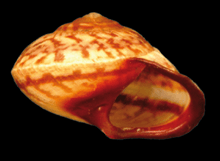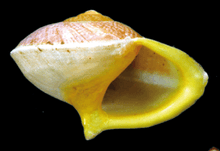Helicina rhodostoma
| Helicina rhodostoma | |
|---|---|
 | |
| Helicina rhodostoma. | |
| Scientific classification | |
| Kingdom: | Animalia |
| Phylum: | Mollusca |
| Class: | Gastropoda |
| (unranked): | clade Neritimorpha clade Cycloneritimorpha |
| Superfamily: | Helicinoidea |
| Family: | Helicinidae |
| Genus: | Helicina |
| Species: | H. rhodostoma |
| Binomial name | |
| Helicina rhodostoma Gray, 1824[1] | |
| Synonyms[2] | |
Helicina rhodostoma is a species of tropical land snail with an operculum, a terrestrial gastropod mollusk in the family Helicinidae.
Shell description
Robert John Lechmere Guppy (1868)[5] noted that this species is not found above 1000 m altitude.[2] Three names have been used for this species, but material by Robinson et al. (2009)[2] shows that the forms intergrade, illustrating the variability of the species. In general, populations from higher altitudes have a more pronounced columellar spine, and are more likely to have a red to reddish-orange aperture, as seen in typical Helicina rhodostoma.[2] Populations from drier, coastal areas tend to lack a columellar spine, and the aperture may be white or yellow.[2] Juvenile specimens of this species often have a hairy periostracum, which is gradually worn off as the snail reaches sexual maturity.[2]
 An apertural view of the shell of Helicina rhodostoma. The height of the shell is 6.90 mm. |
 An apertural view of the shell of Helicina rhodostoma. The height of the shell is 9.24 mm. This shell shows the columellar spine. |
Distribution
Helicina rhodostoma is endemic to the West Indian island of Dominica.[2]
Despite the fact that Helicina rhodostoma was originally erroneously described from Guadeloupe – and in subsequent reports from that island the error has been perpetuated – this species is undoubtedly a Dominican endemic.[2] It has not been found during subsequent surveys of Guadeloupe and Marie-Galante.[2] The fact that no museum material exists labelled “Guadeloupe”, not even in the Muséum national d'histoire naturelle in Paris, indicates that the species has never been collected on that island.[2] The synonymy of Helicina goldfussi and Helicina rhodostoma inermis is confirmed by morphometrics and anatomical studies.[2]
Ecology
Helicina rhodostoma can be found living on trees, on ferns, and also between rocks and gravel.[2]
References
This article incorporates CC-BY-3.0 text from the reference.[2]
- ↑ Gray J. E. (1824). "Monograph of the genus Helicina". Zoological Journal 1: 62-71, pl. 5. Helicina rhodostoma is on page 68, pl. 6, fig. 9.
- 1 2 3 4 5 6 7 8 9 10 11 12 13 Robinson D. G., Hovestadt A., Fields A. & Breure A. S. H. (July 2009). "The land Mollusca of Dominica (Lesser Antilles), with notes on some enigmatic or rare species". Zoologische Mededelingen 83 http://www.zoologischemededelingen.nl/83/nr03/a13
- ↑ Boettger O. (1887). "Vier neue westindische Pneumopomen". Jahrbücher der Deutschen Malakozoologischen Gesellschaft 13: 102-104, pl. 4. Helicina rhodostoma is on the page 103, pl. 4, fig. 10.
- ↑ Wagner A. J. (1907-1911). "Die Familie der Helicinidae". In: Küster H. C. (ed.). Systematisches Conchylien-Cabinet von Martini und Chemnitz, (N.F.) 1(18:2): 1-391, pls 1-70. Helicina rhodostoma is on the page 327, pl. 66 figs 11-12.
- ↑ Guppy R. J. L. (1868). "On the terrestrial mollusks of Dominica and Grenada, with an account of some new species from Trinidad". Annals and Magazine of Natural History (4)1: 429-442.
External links
- Richling I. The Land Snail Family Helicinidae. www.helicina.de